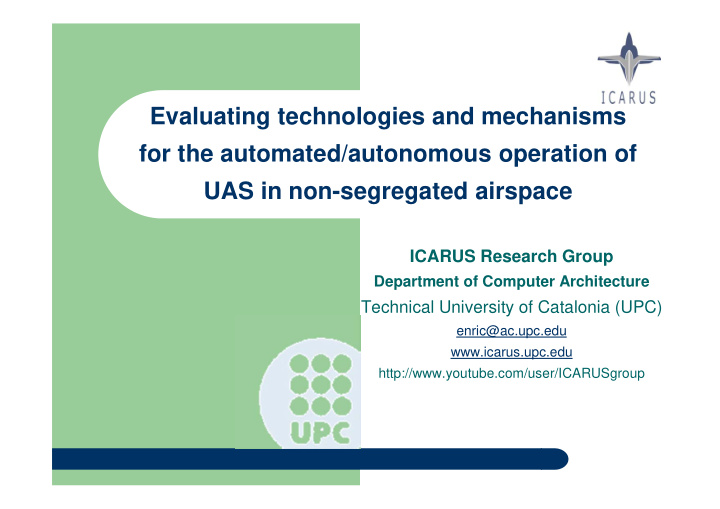



Evaluating technologies and mechanisms for the automated/autonomous operation of UAS in non-segregated airspace ICARUS Research Group Department of Computer Architecture Technical University of Catalonia (UPC) enric@ac.upc.edu www.icarus.upc.edu http://www.youtube.com/user/ICARUSgroup
Smooth UAS, an EEC Project � Project smooth UAS : – Create an environment to evaluate simulated mission-oriented UAS coupled with realistic traffic and ATC interactions. – Followed by the evaluation of contingencies, separation, conflicts, ATC and pilot work-load, lost-link, etc… – Focus on collaborative environments. – Project currently beginning its fourth year. � Motivation: UAS are not point-to-point aircraft – Little realistic experience exists beyond military. – Some “civil” applications exists mainly by NASA and NOAA. – Experience is needed before defining operational issues.
Western States Fire Mission
Outline � ICARUS group presentation � ….
Outline � ICARUS group presentation � ….
Smooth UAS Project Guess, who is the real pilot?
Smooth UAS Project � Conclusions from existing experience: – The complexity of UAS operations will require an increased degree of automation so that the pilot can safely fly. – Manual control seems not an option due to the reduced situational awareness and workload of the pilot. – All evaluated operations required really large set of crews. – Contingencies, separation and ATC factors not yet addressed, “sense and avoid” still dominates.
Flight Plan Specification � The Flight Plan sets the path that the UAS will follow. � It is usually specified as a list of waypoints: – It is difficult to specify complex paths. – It is not aware of mission time circumstances. – Alternative is to build an “intelligent” system that decides the route on the fly (avoid because is non-deterministic). � Our specification mechanism provides: – Leg constructs based on Area Navigation (RNAV) – Control structures for iterating and forking – High-level flight patterns defined through parameters – Alternate plans specification to react to contingencies – Separation manoeuvres
Flight Plan Specification � Flight plan becomes a tree-like structure. � Stages are followed sequentially, while at certain points we need to select specific sub-branches. � Jump to an alternative branches to manage contingencies.
Flight Plan Specification � Complexity of mission-oriented flight plans. � How can we support the pilot? � Will ATC’s be able to manage them?
Smooth UAS Project � Current project activities: – Create a simulation environment in which realistic UAS missions can be implemented in real-time. – Design mission-oriented concepts of operation and systems that support UAS under high levels of automation. – Link the simulator with an ATC environment with actual traffic and controller interaction (eDEP simulator). – Use the environment to evaluate and measure the factors that critically impact UAS operations: � Automated/autonomous pre-planned contingencies. � En-route/mission separation maneuvers. � Lost-link scenarios and the benefits of ADS-B.
ISIS Simulation environment � Overview of the current ISIS components:
ISIS Simulation environment � Flight Monitor (primary display):
ISIS Simulation environment � Partial integration with eDEP:
ISIS Simulation environment
ISIS Simulation environment
ISIS Simulation environment
UAS Contingency Management
UAS Contingency Management
UAS Contingency Management
UAS Contingency Management � Uncertainty levels during contingency reactions : – Pre-planned reaction to contingencies may produce a trade- off between uncertainty and efficiency of the trajectory. – UAS performances need to be taken into account.
UAS Contingency Management � Multiple initial WP allows reusing the same contingency flight plan, that can be designed at convenience.
UAS Conflict Avoidance � Evaluate UAS – ATC interaction: – UAS profiles completely different from other traffic. – UAS interests focused in the mission: may collaborate with ATC to identify best possible separation maneuver.
UAS Conflict Avoidance � A number of closed maneuvers are being investigated: Both facing and chasing traffic. – Assume proactive UAS reaction. –
UAS Conflict Avoidance � Open instructions required by the ATC are also explored: Pilot may need extra support to implement them and get back to – its original flight plan.
UAS Conflict Avoidance
UAS Conflict Avoidance � Interface with eDEP via ADS-B intentions:
UAS Conflict Avoidance � HMI interface for maneuver selection:
UAS Conflict Avoidance � Some preliminary results:
UAS Conflict Avoidance � Some preliminary results:
Conclusions and future work � Lots of work to be done: – UAS performance models to improve trajectory prediction, specially for contingencies and conflicts (BADA-based?). – Collection of “active” separation strategies/maneuvers to be employed by the pilot or autonomously. – Evaluation of the pilot - ATC interaction under a number of relevant increasingly complex scenarios: � UAS with in-flight contingency � En-route and mission separation conflicts � Lost-link? Will ADS-B give confidence to ATC? � Measure UAS reaction capability to all possible ATC requests � Measure the capacity of ATC to manage the situations
Recommend
More recommend